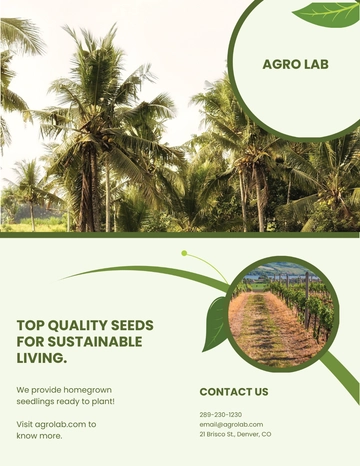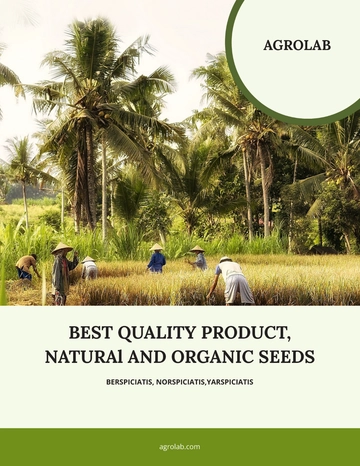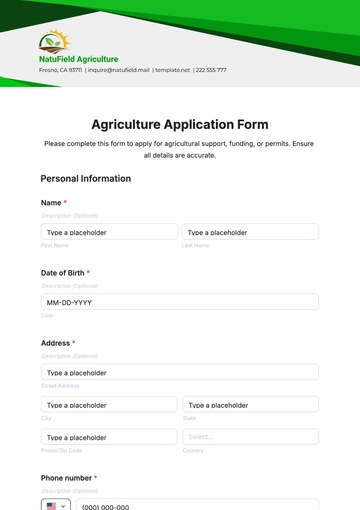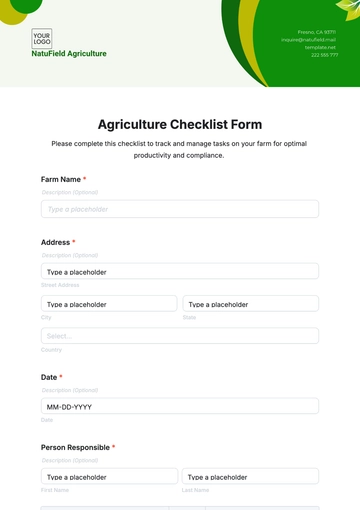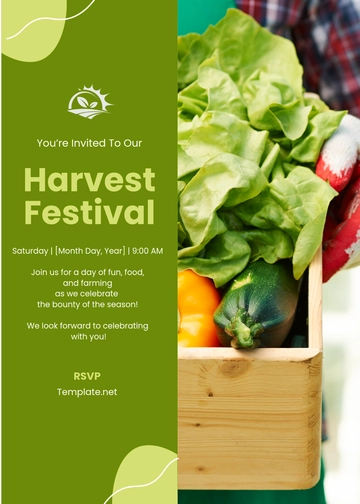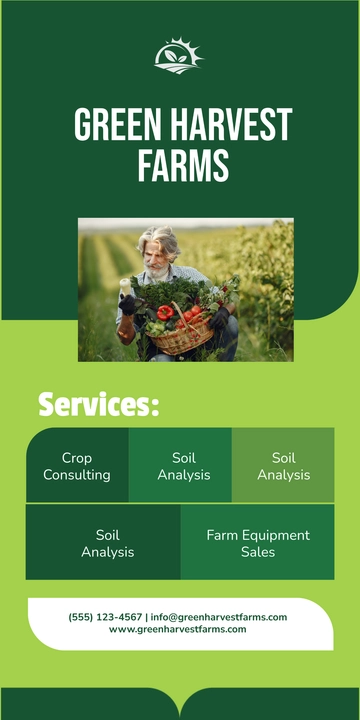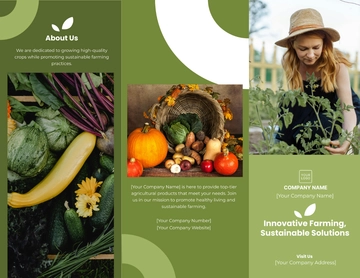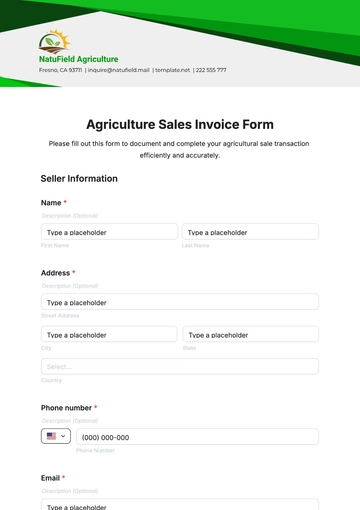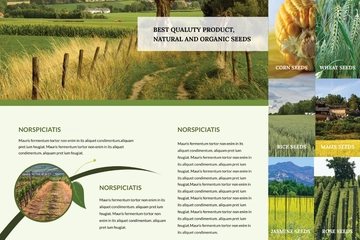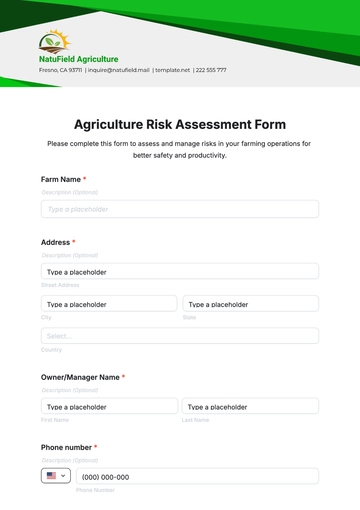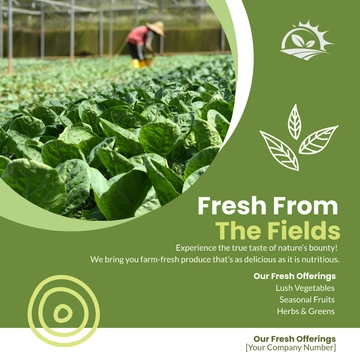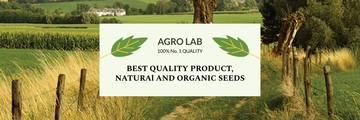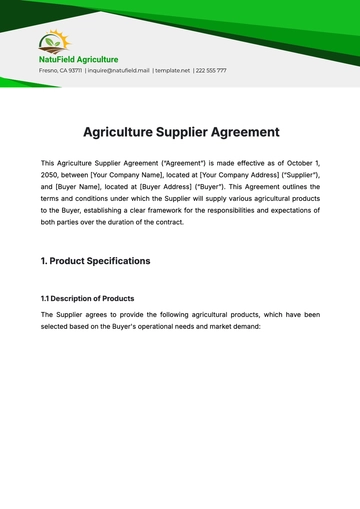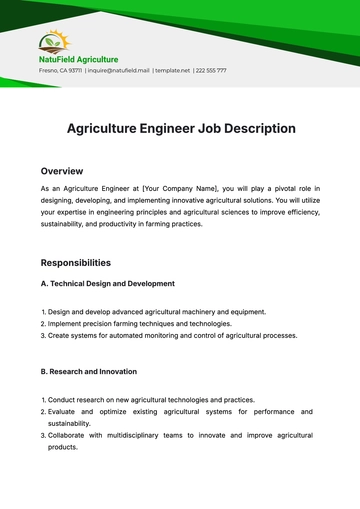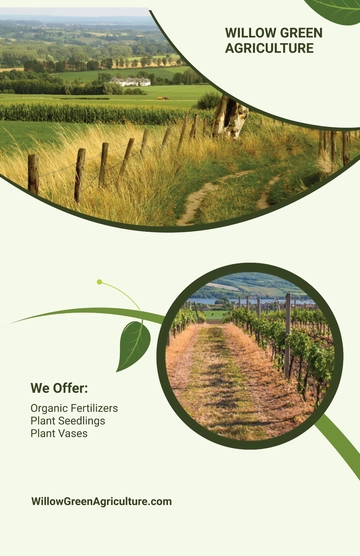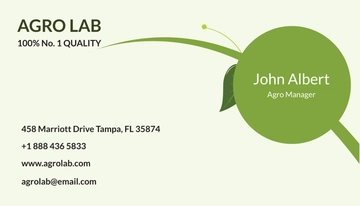Free Agriculture Direct Marketing Strategy
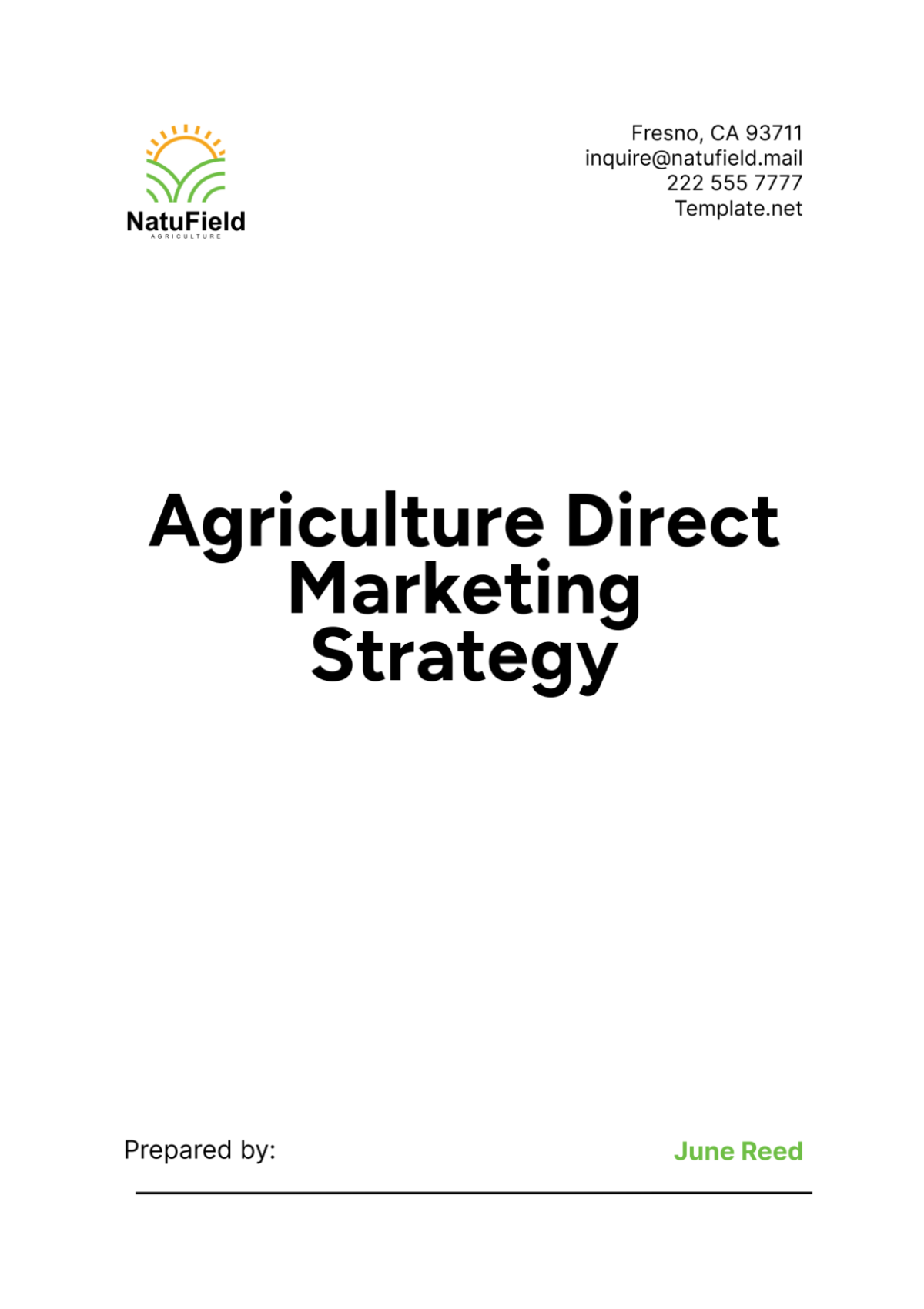
I. Overview
The direct marketing strategy for [Your Company Name] is designed to establish a robust framework for selling agricultural products directly to consumers, thereby eliminating intermediaries and maximizing profit margins. This strategy focuses on understanding market demands, optimizing product offerings, competitive pricing, effective distribution channels, and comprehensive marketing and promotional efforts. The overarching goal is to build strong, lasting relationships with consumers by providing high-quality products and excellent customer service. Through this strategy, [Your Company Name] aims to enhance its market presence, increase customer loyalty, and drive sustainable growth.
II. Market Analysis
A. Market Research
Market research is the foundation of any successful direct marketing strategy. For [Your Company Name], it involves identifying and understanding the target markets, which primarily include local consumers, health-conscious individuals, and those interested in sustainable and organic farming practices. By analyzing consumer demographics, preferences, and purchasing behaviors, we can tailor our products and marketing efforts to meet their specific needs.
A detailed demographic analysis reveals that our target customers are typically aged between 25 and 45, with a strong interest in organic and locally sourced products. They are often well-educated, have a higher disposable income, and value quality over price. Additionally, there is a growing segment of younger consumers who are increasingly concerned about environmental sustainability and are willing to pay a premium for products that align with their values.
B. Competitor Analysis
Understanding the competitive landscape is crucial for positioning [Your Company Name] effectively in the market. Our primary competitors include other local farms, farmers' markets, and organic product retailers. By analyzing their strengths and weaknesses, we can identify opportunities to differentiate our products and services.
Table 1: Competitor Analysis
Competitor Name | Strengths | Weaknesses |
|---|---|---|
Local Farm A | Strong community presence, diverse product range | Limited online presence |
Farmers' Market B | High foot traffic, established customer base | Seasonal operation, inconsistent product quality |
Organic Retailer C | Wide product variety, convenient locations | Higher prices, limited focus on local products |
By leveraging our unique selling points, such as superior product quality, commitment to sustainability, and a strong online presence, [Your Company Name] can effectively compete and capture a larger market share.
III. Product Strategy
A. Product Selection
The selection of products for direct marketing is a critical component of our strategy. At [Your Company Name], we focus on products that meet the high standards of quality and sustainability that our customers expect. Our product range includes a variety of fresh fruits and vegetables, dairy products, eggs, and value-added items such as jams, pickles, and baked goods.
Our criteria for product selection include factors such as consumer demand, profitability, and our capacity to produce and deliver consistently high-quality items. We also consider the potential for differentiating our products from those of competitors. For example, we might introduce heirloom varieties of vegetables or specialty products that are not widely available in the local market.
B. Quality Assurance
Maintaining high standards of quality is essential for building and retaining customer trust. [Your Company Name] implements rigorous quality control procedures at every stage of the production and distribution process. This includes regular inspections of crops, adherence to organic farming practices, and thorough testing of products for safety and quality.
Our quality assurance process is documented and standardized to ensure consistency. For instance, we follow strict guidelines for harvesting, packaging, and storage to preserve the freshness and nutritional value of our products. Additionally, we continuously seek feedback from customers to identify areas for improvement and ensure that our products meet their expectations.
IV. Pricing Strategy
A. Pricing Models
Pricing is a critical aspect of the direct marketing strategy for [Your Company Name]. We employ a variety of pricing models to ensure that our products are competitively priced while still generating a reasonable profit margin. Our primary pricing strategies include cost-plus pricing and value-based pricing.
In the cost-plus pricing model, we calculate the total cost of production, including raw materials, labor, and overheads, and add a markup to determine the selling price. This approach ensures that all costs are covered and a consistent profit margin is maintained.
Table 2: Cost-Plus Pricing Example
Product | Production Cost ($) | Markup (%) | Selling Price ($) |
|---|---|---|---|
Organic Tomatoes | 2.00 | 50% | 3.00 |
Free-Range Eggs | 1.50 | 60% | 2.40 |
Homemade Jam | 3.00 | 40% | 4.20 |
In the value-based pricing model, we set prices based on the perceived value of the product to the customer. This approach allows us to charge a premium for products that offer unique benefits, such as organic certification, superior quality, or sustainable production practices.
B. Discount and Promotion Policies
To attract and retain customers, [Your Company Name] implements various discount and promotion policies. Seasonal discounts are offered during peak harvest times to encourage bulk purchases and reduce inventory. For instance, customers may receive a 10% discount on all purchases during the summer harvest season.
We also offer loyalty programs to reward repeat customers. For example, customers who make a minimum number of purchases within a specified period may receive a discount on their next order or a free product. Additionally, we run special promotions during holidays and community events to increase brand visibility and attract new customers.
V. Distribution Channels
A. Direct-to-Consumer Sales
Direct-to-consumer sales are a cornerstone of our marketing strategy. By selling directly to consumers, [Your Company Name] can establish strong relationships with customers, receive immediate feedback, and maintain control over pricing and product presentation.
Farmers' markets are a key distribution channel for direct-to-consumer sales. These markets provide an opportunity to engage with customers face-to-face, showcase our products, and build brand loyalty. We participate in several local farmers' markets, ensuring a regular presence in the community.
Community-supported agriculture (CSA) programs are another effective distribution channel. In a CSA program, customers purchase a share of the farm's harvest in advance and receive regular deliveries of fresh produce throughout the season. This model provides a steady stream of revenue for the farm and fosters a strong connection between consumers and producers.
B. Online Sales
The rise of e-commerce has opened new opportunities for direct marketing. [Your Company Name] leverages online sales platforms to reach a broader audience and provide convenient shopping options for customers. Our e-commerce platform features an intuitive interface, detailed product descriptions, and secure payment options.
Social media sales are also an important component of our online strategy. By leveraging platforms such as Facebook, Instagram, and Twitter, we can promote our products, engage with customers, and drive traffic to our online store. Social media allows us to reach a wider audience and build a community around our brand.
C. Local Retail Partnerships
In addition to direct-to-consumer and online sales, [Your Company Name] establishes partnerships with local retail outlets. These partnerships allow us to expand our market reach and increase brand visibility. We collaborate with local grocery stores, health food shops, and restaurants to offer our products to their customers.
By maintaining strong relationships with retail partners, we can ensure that our products are prominently displayed and effectively marketed. This approach not only increases sales but also enhances our brand reputation within the local community.
VI. Marketing and Promotion
A. Branding and Messaging
A strong brand identity is essential for differentiating [Your Company Name] in the marketplace. Our branding strategy focuses on conveying the values of quality, sustainability, and community engagement. The brand message highlights our commitment to organic farming practices, superior product quality, and support for local communities.
Our branding elements, including the logo, packaging design, and promotional materials, reflect these values. Consistent branding across all touchpoints helps to build recognition and trust among consumers. We emphasize storytelling in our marketing efforts, sharing the history of the farm, the people behind the products, and the sustainable practices we follow.
B. Advertising and Promotion
Effective advertising and promotion are crucial for raising awareness and driving sales. [Your Company Name] employs a mix of traditional and digital marketing channels to reach our target audience. Traditional media, such as flyers, newspapers, and radio ads, are used to reach local customers and promote our presence at farmers' markets and community events.
Digital marketing is a key component of our promotional strategy. We use social media platforms to engage with customers, share product updates, and promote special offers. Email campaigns are used to keep customers informed about new products, seasonal availability, and upcoming events.
Table 3: Marketing Channels and Strategies
Marketing Channel | Strategy | Frequency |
|---|---|---|
Social Media (Facebook) | Product promotions, customer engagement | Daily posts |
Email Campaigns | Newsletters, special offers, event invitations | Bi-weekly |
Local Newspapers | Advertisements, feature articles | Monthly ads |
Farmers' Markets | On-site promotions, product sampling | Weekly presence |
C. Public Relations and Community Engagement
Building strong relationships with the community is a key aspect of our marketing strategy. [Your Company Name] actively participates in local events and hosts farm tours to engage with the community and promote our products. These activities provide an opportunity to educate consumers about our farming practices, share our story, and build brand loyalty.
We also collaborate with local organizations and schools to promote healthy eating and sustainable agriculture. By participating in community events and supporting local causes, we can enhance our brand reputation and build a loyal customer base.
VII. Customer Relationship Management
A. Building Customer Relationships
At [Your Company Name], building and maintaining strong customer relationships is a priority. This involves creating a positive customer experience at every touchpoint, from the initial contact through the purchase and post-purchase stages. Our approach includes personalized communication, exceptional customer service, and consistent follow-ups to ensure customer satisfaction.
We emphasize understanding our customers' needs and preferences. This is achieved through regular surveys, feedback forms, and direct interactions at farmers' markets and community events. By gathering and analyzing this information, we can tailor our products and services to better meet customer expectations.
B. Loyalty Programs
Loyalty programs are an effective way to reward repeat customers and encourage long-term engagement. [Your Company Name] offers a variety of loyalty initiatives, such as a points-based system where customers earn points for every purchase, which can be redeemed for discounts or free products. We also offer exclusive access to special events, early bird discounts on new products, and personalized offers based on purchasing history.
Table 4: Loyalty Program Structure
Loyalty Level | Points Required | Benefits |
|---|---|---|
Bronze | 0-100 | 5% discount on next purchase |
Silver | 101-300 | 10% discount, early access to new products |
Gold | 301-500 | 15% discount, exclusive event invitations |
Platinum | 501+ | 20% discount, free seasonal product samples |
C. Customer Service
Exceptional customer service is a cornerstone of [Your Company Name]'s direct marketing strategy. Our customer service team is trained to handle inquiries, complaints, and feedback promptly and professionally. We offer multiple channels for customer support, including phone, email, and social media.
Our commitment to customer service extends beyond resolving issues. We proactively reach out to customers to ensure their satisfaction with our products and services. This includes follow-up emails after purchases, thank you notes for large orders, and personalized recommendations based on previous purchases.
VIII. Sales Techniques
A. Personal Selling
Personal selling is a key component of our direct marketing strategy. This technique involves face-to-face interactions with customers at farmers' markets, community events, and during farm tours. Our sales representatives are knowledgeable about our products and farming practices, allowing them to effectively communicate the benefits and unique qualities of our offerings.
The personal selling approach helps build trust and rapport with customers. It provides an opportunity to answer questions, address concerns, and provide personalized recommendations. This direct interaction is invaluable in creating a loyal customer base and encouraging repeat business.
B. Cross-Selling and Up-Selling
Cross-selling and up-selling techniques are employed to increase the average order value and enhance customer satisfaction. Cross-selling involves suggesting complementary products that enhance the customer's purchase, such as pairing fresh vegetables with homemade sauces or offering recipe booklets with seasonal produce.
Up-selling, on the other hand, encourages customers to purchase higher-end products. For example, we might highlight the benefits of premium organic options or larger product quantities for frequent buyers. These techniques are integrated into our sales process both in-person and online.
C. Event Marketing
Event marketing is an effective way to promote our products and engage with the community. [Your Company Name] organizes and participates in various events, such as local food festivals, cooking demonstrations, and farm-to-table dinners. These events provide a platform to showcase our products, educate consumers about sustainable agriculture, and strengthen our brand presence.
Events also offer a unique opportunity for experiential marketing, where customers can see, taste, and learn about our products firsthand. This immersive experience helps to build a deeper connection with our brand and encourages word-of-mouth referrals.
IX. Digital Marketing Strategy
A. Website Optimization
Our website is a crucial component of our digital marketing strategy. [Your Company Name] invests in creating a user-friendly, visually appealing website that provides comprehensive information about our products, farming practices, and company values. The website features an e-commerce platform, allowing customers to easily browse and purchase products online.
To enhance the user experience, we ensure that the website is mobile-friendly and optimized for fast loading times. We also implement search engine optimization (SEO) techniques to improve our visibility on search engines, making it easier for potential customers to find us online.
B. Social Media Engagement
Social media platforms are powerful tools for connecting with our audience and promoting our products. [Your Company Name] maintains active profiles on Facebook, Instagram, and Twitter, where we share updates about new products, upcoming events, and farming insights. We also use social media to engage with customers through comments, direct messages, and interactive posts.
We regularly post high-quality images and videos that showcase our farm, products, and community involvement. These visual elements help to create an emotional connection with our audience and encourage sharing and engagement.
Table 5: Social Media Content Plan
Platform | Content Type | Frequency |
|---|---|---|
Product updates | 3 times per week | |
Farm photos, stories | Daily | |
Event announcements | 2 times per week | |
YouTube | Educational videos | Monthly |
C. Email Marketing
Email marketing is an effective way to communicate with our customers and keep them informed about our latest offerings. [Your Company Name] sends out regular newsletters that include product highlights, seasonal recipes, farming tips, and upcoming events. We also use email campaigns to promote special offers and discounts.
Our email marketing strategy is personalized and segmented, allowing us to tailor content to different customer groups based on their preferences and purchasing history. This targeted approach increases the relevance and effectiveness of our communications.
X. Distribution Logistics
A. Supply Chain Management
Efficient supply chain management is essential for ensuring that our products reach customers in optimal condition. [Your Company Name] follows best practices for sourcing, production, and distribution to minimize waste and maximize efficiency. This includes using environmentally friendly packaging, optimizing delivery routes, and maintaining a reliable transportation network.
We collaborate with local suppliers and logistics partners to streamline our operations and reduce our carbon footprint. By maintaining strong relationships with these partners, we can ensure timely deliveries and consistent product quality.
B. Inventory Management
Effective inventory management is critical for meeting customer demand and minimizing losses. [Your Company Name] employs advanced inventory management systems to track stock levels, monitor sales trends, and forecast future demand. This helps us maintain the right balance of products and avoid overstocking or stockouts.
Our inventory management system is integrated with our e-commerce platform, allowing real-time updates on product availability. This ensures that customers always have accurate information when placing orders online.
C. Delivery and Fulfillment
Reliable delivery and fulfillment are key to customer satisfaction. [Your Company Name] offers multiple delivery options to accommodate different customer preferences, including home delivery, pickup at farmers' markets, and collection points at local retail partners.
We use a combination of in-house delivery services and third-party logistics providers to ensure efficient and timely deliveries. Our fulfillment process includes careful packaging to protect products during transit and minimize environmental impact.
XI. Financial Management
A. Budgeting and Forecasting
Effective financial management is essential for the success of our direct marketing strategy. [Your Company Name] uses detailed budgeting and forecasting to plan and allocate resources efficiently. This involves projecting sales, estimating costs, and setting financial targets for different aspects of our operations.
Our budgeting process is iterative and involves regular reviews to ensure that we stay on track and make necessary adjustments. By closely monitoring our financial performance, we can identify areas for improvement and take proactive measures to address any issues.
B. Revenue Streams
[Your Company Name] generates revenue through multiple channels, including direct sales at farmers' markets, online sales, CSA programs, and local retail partnerships. Diversifying our revenue streams helps to mitigate risk and ensure a steady flow of income.
We also explore opportunities for additional revenue, such as offering farm tours, workshops, and agritourism experiences. These activities not only generate income but also enhance our brand visibility and community engagement.
Table 6: Revenue Stream Analysis
Revenue Stream | Contribution (%) | Growth Potential |
|---|---|---|
Farmers' Markets | 40% | High |
Online Sales | 30% | Moderate |
CSA Programs | 20% | High |
Retail Partnerships | 10% | Low |
C. Cost Management
Cost management is critical for maintaining profitability. [Your Company Name] employs various strategies to control costs, such as bulk purchasing of raw materials, optimizing production processes, and reducing waste. We also invest in technology and equipment that improve efficiency and reduce labor costs.
Regular financial audits and performance reviews help us identify cost-saving opportunities and ensure that we are operating within budget. By maintaining a focus on cost management, we can sustain our profitability and reinvest in the growth of the business.
XII. Evaluation and Improvement
A. Performance Metrics
Evaluating the success of our direct marketing strategy requires the use of key performance metrics. [Your Company Name] tracks a range of metrics to assess the effectiveness of our marketing efforts, sales performance, and customer satisfaction. These metrics include sales revenue, customer acquisition and retention rates, website traffic, and social media engagement.
By regularly monitoring these metrics, we can identify trends, measure progress, and make data-driven decisions to improve our strategy. Performance reviews are conducted quarterly to ensure that we stay on track and achieve our goals.
B. Customer Feedback
Customer feedback is invaluable for continuous improvement. [Your Company Name] actively seeks feedback through surveys, reviews, and direct interactions. We analyze this feedback to identify strengths, weaknesses, and opportunities for enhancement.
Feedback mechanisms are integrated into our online and offline platforms, making it easy for customers to share their opinions. We also conduct focus groups and customer interviews to gain deeper insights into their experiences and expectations.
C. Continuous Improvement
Continuous improvement is a core principle of our direct marketing strategy. [Your Company Name] is committed to regularly reviewing and refining our processes, products, and services to better meet customer needs and market demands. This involves staying updated with industry trends, adopting new technologies, and implementing best practices.
We foster a culture of innovation and encourage our team to contribute ideas for improvement. By continuously evolving and adapting, we can maintain our competitive edge and achieve long-term success in the agriculture market.
Table 7: Continuous Improvement Plan
Improvement Area | Initiative | Timeline |
|---|---|---|
Product Quality | Introduce new organic varieties | Q1 |
Customer Service | Implement live chat support | Q2 |
Marketing Strategy | Launch influencer partnerships | Q3 |
Operational Efficiency | Upgrade inventory system | Q4 |
- 100% Customizable, free editor
- Access 1 Million+ Templates, photo’s & graphics
- Download or share as a template
- Click and replace photos, graphics, text, backgrounds
- Resize, crop, AI write & more
- Access advanced editor
Enhance your outreach with Template.net's customizable and editable Agriculture Direct Marketing Strategy Template. Use the AI Editor Tool for precise strategy formulation. This user-friendly template ensures effective direct marketing plans, boosting customer engagement and sales in your agricultural business.
